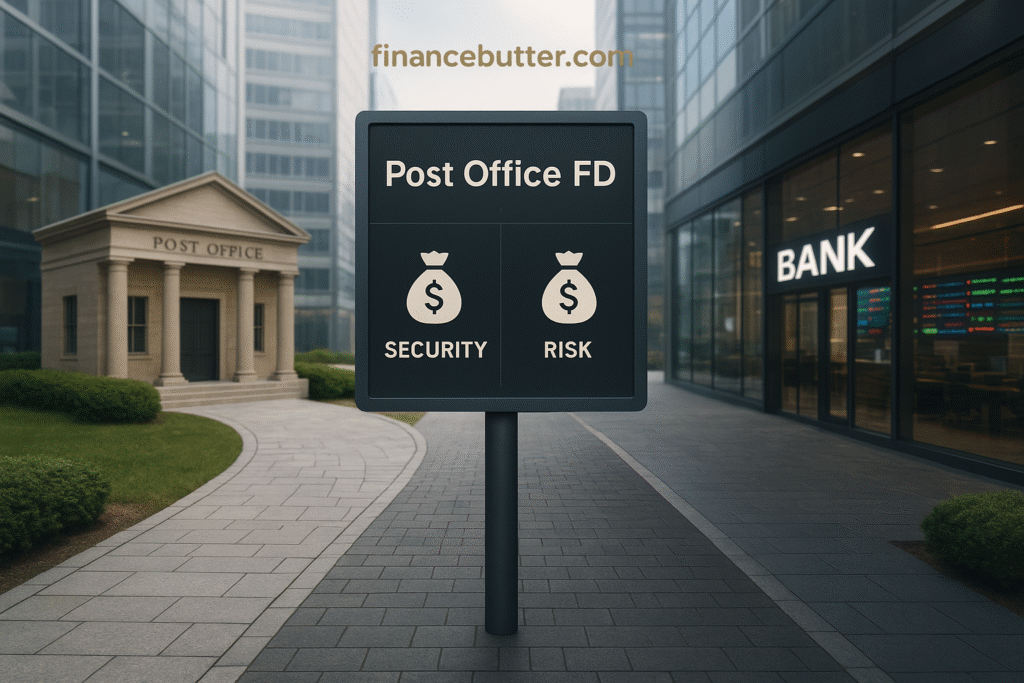Imagine a savings option that’s as dependable as your mom’s home-cooked dal—simple, comforting, and always there when you need it. That’s the Post Office Fixed Deposit (FD) for you. It’s not about chasing crypto highs or stock market thrills; it’s about rock-solid, government-backed growth you can trust. With inflation creeping and markets playing a rollercoaster, this FD remains a favorite for millions who want their money to grow without sleepless nights.

Why does it still shine? It’s got the full faith of the Government of India—no risk of losing your principal, unlike bank FDs capped at ₹5 lakh insurance. Interest rates hover between 6.9% and 7.5% p.a., beating inflation while keeping things predictable. Whether you’re a young saver tucking away your first salary, a parent planning for kids, or a retiree wanting steady returns, this scheme fits like a glove. Accessible at over 1.5 lakh post offices, it’s as close as your neighbourhood kirana store. In this guide, we’ll break down how it works, the rates, tax perks, and why it might be your smartest financial move yet. Ready to ditch the hype for something real? Let’s dive in.
What is Post Office FD?
Think of the Post Office Fixed Deposit as a piggy bank with a government guarantee. Officially called the National Savings Time Deposit, it’s a no-fuss savings scheme where you park a lump sum for a fixed term and earn steady interest, compounded quarterly and paid yearly. It’s been a household name for decades, designed to help everyone—from daily wagers to retirees—grow their money safely.
How does it work? Choose a tenure: 1, 2, 3, or 5 years. Anyone eligible for a Post Office Savings Account can open one—individuals, joint holders (up to three adults), or guardians for kids above 10. NRIs are out of luck; it’s for Indian residents only. Start with as little as ₹1,000, in multiples of ₹100, with no upper cap—perfect for small savers or those with a windfall. Interest kicks in from day one, and at maturity, you get your principal plus earnings. Need cash early? Withdraw after 6 months, but expect a penalty (like 1-2% less interest). With rates at 6.9%-7.5%, it’s a low-risk way to build your nest egg. Plus, with post offices everywhere, it’s as accessible as it gets. It’s like planting a seed and watching it grow—slow, steady, and zero stress.
Post Office FD Schemes
The Post Office offers a neat lineup under its Time Deposit schemes, all about straightforward savings. The core is the Time Deposit Account, with tenures of 1, 2, 3, or 5 years. The 5-year version doubles as a tax-saver, qualifying for Section 80C deductions up to ₹1.5 lakh. You can open multiple accounts, solo or joint, and even move them between post offices if you relocate. Nomination is mandatory for peace of mind, and it’s all manageable with cash or cheque at any branch.
What makes it stand out? Simplicity and safety. Interest compounds quarterly, paid annually, and the government’s backing means your money’s untouchable. Compare that to bank FDs: Both offer fixed returns, but banks cap insurance at ₹5 lakh, while Post Office FDs have no such limit. Rates are close—PO at 6.9%-7.5%, banks around 6.5%-7.3%—but the Post Office edges out for rural reach and no hidden charges. Banks might throw in online perks or extra tenures, but for guaranteed safety and tax benefits on the 5-year scheme, the Post Office is hard to beat. It’s like choosing between a flashy sedan and a sturdy SUV—banks are slick, but the Post Office gets you through any terrain, no sweat.
Fixed Deposit Rates in Post Office
Let’s talk numbers—the heart of any FD decision. As of January 2026, Post Office FD rates are holding steady: 6.9% p.a. for 1 and 2 years, 7.1% for 3 years, and 7.5% for 5 years. These are compounded quarterly, so your money grows faster than simple interest suggests. The rates are set by the Ministry of Finance, reviewed every quarter, and haven’t budged since last year’s minor tweak when the 3-year rate bumped up 0.1% to match inflation trends.
How does this stack up? Last year, rates were nearly identical, with a brief dip to 6.8% for 1-year in mid-2025 before rebounding. The consistency reflects stable G-Sec yields and RBI’s steady hand. For ₹1 lakh, you’re looking at roughly ₹7,000 annually for shorter terms and up to ₹43,000 over 5 years (more on that later). Banks like SBI (6.8%-7.1%) and HDFC (up to 7.25%) are in the same ballpark, but the Post Office’s sovereign guarantee makes it the safer bet.
Why care? These rates offer a hedge against inflation without the market’s mood swings. The 5-year tenure’s 7.5% is a standout, especially with tax benefits. If rates shift mid-year (say, inflation spikes), expect a slight nudge, but for now, it’s a predictable deal. Whether you’re saving for a vacation or a kid’s college fund, these rates deliver peace of mind with a side of steady growth. Stick around for the table to see exactly how your money multiplies.
Post Office FD Interest Rate for Senior Citizens
If you’re 60 or older, Post Office FDs are like a warm cup of chai—reliable and just right. Rates match the general ones: 6.9% for 1-2 years, 7.1% for 3 years, and 7.5% for 5 years, compounded quarterly. Unlike banks, there’s no extra 0.5% for seniors, but the real win is tax perks. Under Section 80TTB, interest up to ₹50,000 is tax-free annually, boosting your effective returns. The 5-year FD also qualifies for Section 80C, letting you deduct up to ₹1.5 lakh of principal from taxable income.

Why’s this a big deal? With rising costs, that tax shield stretches your rupees. For ₹2 lakh in a 5-year FD at 7.5%, you earn ~₹85,000 interest, with up to ₹50,000 tax-free. No TDS hassle either—Post Office skips it, unlike banks. Need cash? Withdraw after 6 months (with a penalty), or pledge for a low-rate loan. Joint accounts with a spouse or nomination keep things flexible.
For retirees, it’s a no-drama way to grow savings, especially in rural areas with post offices galore. Pair it with the Senior Citizen Savings Scheme for monthly income, and you’ve got a solid plan. It’s not about chasing trends—it’s about knowing your money’s safe and working for you.
Fixed Deposit Interest Rates of Post Office
Time to get down to brass tacks with a clear picture of Post Office FD rates and returns. Below is the tenure-wise breakdown, with interest compounded quarterly and paid annually.
Tenure | Interest Rate (p.a.) | Annual Interest on ₹1 Lakh | Maturity Value on ₹1 Lakh (Approx.) |
1 Year | 6.9% | ₹6,900 | ₹1,07,037 |
2 Years | 6.9% | ₹13,800 (cumulative) | ₹1,14,611 |
3 Years | 7.1% | ₹21,900 (cumulative) | ₹1,22,596 |
5 Years | 7.5% | ₹40,300 (cumulative) | ₹1,43,149 |
How to Open Post Office FD Online?
Opening a Post Office FD is now as easy as ordering biryani online, thanks to digital upgrades. If you’ve got a Post Office Savings Account (POSA), head to the India Post e-banking portal (ebanking.indiapost.gov.in) or IPPB app. Log in, click “Fixed Deposit,” pick your tenure (1-5 years), enter amount (min ₹1,000), and transfer funds from your POSA. Done—e-receipt in hand, passbook updated.
Here’s the drill:
- Log in with POSA credentials (Aadhaar-linked mobile for OTP).
- Choose Time Deposit tenure.
- Add principal, nominee details (mandatory).
- Fund via POSA or cheque (offline).
- Confirm and save receipt.
No POSA? Visit a branch to open one, then link it online. Docs needed: ID (Aadhaar/PAN/Voter ID), address proof, two photos, deposit amount. Minors need a guardian and birth certificate; joint accounts take up to three names. Auto-renewal’s a click away for hassle-free growth. With IPPB’s slick interface, it’s a 10-minute job—rural or urban, you’re covered.
Taxation Rules for Post Office FD
Taxes can sting, but Post Office FDs keep it light. Interest is taxed as “Income from Other Sources” at your slab rate (5%-30%). Unlike banks, there’s no TDS, so you report it in your ITR—less hassle, more control. The 5-year FD sweetens the deal with Section 80C deductions up to ₹1.5 lakh on principal. Seniors get Section 80TTB, exempting up to ₹50,000 interest annually.
For example, ₹2 lakh in a 5-year FD at 7.5% earns ~₹85,000 interest. Seniors pay zero tax on ₹50,000 of it; others deduct ₹1.5 lakh from taxable income. Early withdrawal? Interest till then is taxed. File Form 15G/H if income’s below exemption to avoid TDS elsewhere. It’s a clean, tax-smart way to grow wealth.
Pros and Cons of Post Office FD
Pros: Government-backed safety—no risk, period. Returns of 6.9%-7.5% beat inflation, with quarterly compounding for extra growth. Low entry (₹1,000), 80C tax breaks on 5-year, and 1.5 lakh branches for access. Joint accounts, nominations, and transfers add flexibility.
Cons: Locked funds—early withdrawal post-6 months has penalties. Fixed returns miss inflation spikes, and no senior rate boost. Limited online access (needs POSA), and annual payouts skip monthly needs. Max 5 accounts/person caps big plans.
For risk-averse savers, the pros outweigh the cons—safe, steady, done.a

Post Office FD vs Bank FD
PO FD or bank FD? Rates are similar: PO at 6.9%-7.5%, banks like SBI/HDFC at 6.5%-7.3% (small finance banks reach 7.8%). PO’s 5-year 7.5% tops; banks favor short terms. Safety? PO’s sovereign guarantee surpasses DICGC’s ₹5 lakh cap. Banks provide loans/overdrafts; PO’s stricter after 6 months.
Seniors: Banks add 0.4%-0.5%, but PO’s 80TTB tax-free ₹50k evens it. No TDS on PO; banks deduct over ₹40k. Young savers (20s-40s) may prefer banks’ digital ease; retirees love PO’s zero-risk vibe. Families? PO’s joint accounts shine. Split deposits if you want both worlds.
Post Office FD isn’t glamorous, but it’s gold—safe, steady returns at 6.9%-7.5%, tax perks, and government backing. It’s for anyone who values sleep over market stress: young savers building funds, families securing futures, or retirees eyeing tax-free income. Rural folks? Post offices are your backyard bank. Not for you if you need quick cash or chase high-risk yields—try mutuals instead. Ladder tenures, use the calculator, and let compounding do its thing. Your savings deserve this kind of love—start small, grow big, worry less.
